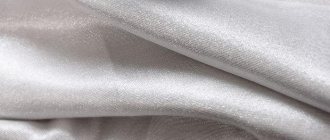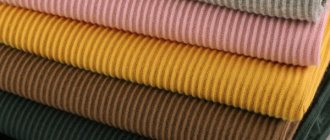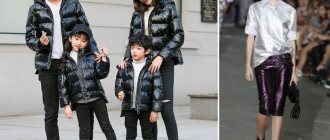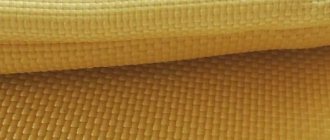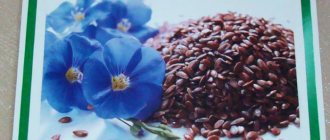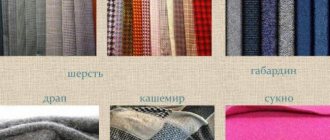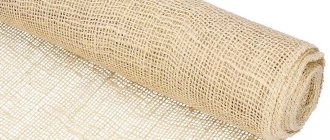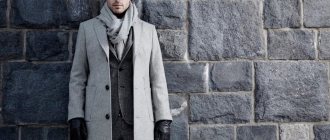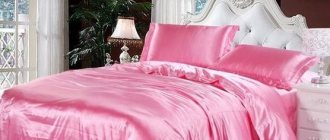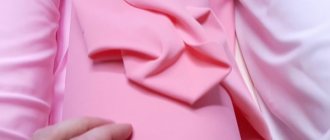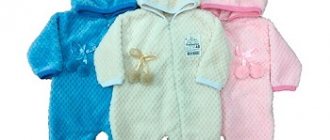Lurex is glamor and shine. The history of the origin, varieties and applications of metallized yarn are rich and interesting, so this article will be devoted to this topic.
Shiny fabric has long been one of the most popular materials for clothing. Lurex is made from the thinnest metal plates, cut into narrow strips. The color of the thread depends on the shade of the adhesive composition applied to the base of the metal fiber.
Type and general description
Lurex is the name of a special type of metallized thread, which is obtained by covering thin and shiny metal fibers with a dyed polyester film, giving the yarn a characteristic shine. The metal commonly used is aluminum, but also brass, nickel and copper.
Various fabrics with lurex
Lurex is produced using the lamination method. Metal threads are placed between two layers of polyamide (polyamide film is most often used, but sometimes polyester or viscose is used instead), after which the metal is sealed inside under pressure and at high temperature. The fibers are then cut into longitudinal strips and formed into a thread.
Lurex is called both a shiny metal thread (it is too hard and brittle, so it is not used on its own), and a material or yarn with its addition. Lurex fabric is made by weaving a metal thread with other fibers, which can be either natural or synthetic.
Lurex fabrics are produced in many countries. The Russian market presents mainly products from China, Korea, Turkey, and Italy.
Rules of care
The properties of lurex fabrics are determined both by their basic composition and the percentage of shiny fiber. Although it is considered quite durable, nevertheless, mechanical stress and high temperature can ruin the appearance of the product. Therefore, Lurex should be washed only in a gentle mode using neutral detergents. Instead of spinning, it is recommended to straighten the product and let the water drain, then dry it away from heat sources. It is better to dry knitwear in a horizontal position. Most lurex fabrics do not require ironing. If necessary, it is carried out from the wrong side in the “synthetic” mode, while it is advisable to use a fabric pad and avoid steaming.
Origin story
People began decorating fabric with inclusions of precious metals a very long time ago. Researchers claim that the ancient Egyptians, as well as the inhabitants of Babylon and Persia, did this. First, the plates of gold and silver were rolled out to the maximum degree of thinness and the thread was pulled out. Then the production was improved: a silver thread with a thin layer of gold applied to it was wound onto a silk thread, which was the basis of the fabric.
The shiny thread we know was invented in 1946 in the USA. Since then it has gone through several modernizations, but still bears the old brand name Lurex, which is a global brand in the production of metallized threads.
In the early 1960s, tobacco giants began using lurex thread to quickly and easily open cigarette packs. In the 1970s-1980s, clothing with lurex became a symbol of glamor and a must-have attribute of nightlife.
By the end of the 20th century, the fashion for lurex ceased to be widespread, and the fabrics themselves with shiny threads became more restrained.
The demand for shiny fabric has not disappeared. In 2021, the company will launch a new B2C fashion collection under its own brand MAISON LUREX with the opening of the first flagship store in Paris.
Why are Italian fabrics good?
Italy has long gained fame as the flagship of the world fashion capital. Of course, the French competitors in the high fashion industry are also not in the last role, and they have a huge influence on the fashion industry... However, Italian craftsmen (both collection designers and fabric manufacturers) have always been able to find their own unique path. Italian style cannot be confused; Italian fabrics are equally easily recognizable in Moscow and in any other city on the planet.
Could it be otherwise if it was this land that gave humanity such creators as Leonardo, Raphael, Botticelli, whose works the country became known as the homeland of people with ideal taste, with an innate sense of style. It seems that knowledge of the laws of beauty is inherited by Italians with genes.
Probably every fashionista’s heart skips a beat when we once again hear the words Max Mara, Valentino, Versace...
Italian Masters are distinguished by impressive courage, they inspire admiration for their desire for innovation and at the same time reverent love for existing traditions. Every year on the catwalks we see not only unsurpassed collections, but also new Italian fabrics, which immediately become the basis on which tens of thousands of ateliers operate around the world; Italian fabrics are bought in small wholesale by millions of private tailors.
In fact, Italian fabric manufacturers rely on more than just stunning aesthetics. Everyone here knows a lot about quality, modern technology, and reliability. Excellent raw materials are always available here; the arsenal of the enterprises includes technologically advanced machines and knowledgeable, experienced people who value accuracy and precision.
They say that all roads lead to Rome, but in our case, all roads simply lead to Italy. Fabric production in this country is slightly localized. More accurately, we can note the conditional division of the territory into 3 conglomerates:
- Emilia Romagna focuses more on knitwear.
- Florence is famous for its traditions of working with wool (although, of course, there is everything here).
- The north of the country specializes in silk fabrics and other “dressy” materials for high fashion.
Everywhere in Italy, fabrics are offered to the client either as a regular product or in stock quantities. Regular materials are produced exclusively to your order. If you want to buy just such Italian fabric wholesale, then there will be no problems with either quantity or colors. But you will have to pay more and, most likely, the buyer will face the problem of a minimum order quantity limit.
Stock lots are usually those fabrics that were previously ordered by some famous brands. The advantages of textile stock include unsurpassed quality and “proven” popular design. The demand for Italian fabric from such residual batches is also at a relatively low price, but you need to understand that the quantity of stock goods is limited, and you should not forget that you will have to choose a product from models already existing in warehouses.
Experience shows that it is quite difficult to choose and order fabrics in bulk directly from Italy. But for this you don’t need to go to Europe or cooperate with intermediaries and brokers, just contact us by phone and, after consultation, make a purchase online, or we recommend coming to the warehouse of the IMBAL store in Moscow, which is located near the Kurskaya metro station.
It is clear that there are a lot of fabrics (different and necessary), therefore, despite all the abundance of goods, fabric stores are still popular, and with the advent of the worldwide information network, buying or ordering the necessary fabric has become even easier and faster. However, there remains one question that the buyer himself has to decide every time: What to choose? Which fabric will look better in a business suit or a summer sundress? What to buy for trousers, a coat, a cardigan – this material or this one? You always have to choose, and to do it correctly, you need to know the properties of fabrics, their features and main purpose.
For example, you can sew a light summer coat from silk, but the main purpose of this fabric is to sew elegant clothes. Linen fabrics are excellent, natural, their natural basis justifies some disadvantages in use, but linen business suits will hang in the wardrobe more than actually be worn. This is the case with almost any fabric, so the purpose determines the choice, and the more diverse the store’s assortment, the easier it is to find the right fabric. In our store you can find almost everything - from exclusive hand-painted canvases to fabrics for sewing products for every day.
This is interesting: Percale: what kind of fabric is it - description, elite material for linen
Composition and properties of the material
In modern materials, the content of metallized thread ranges from 3 to 30% , depending on the purpose of the fabric. Lurex is mixed with almost any fiber - cotton, wool, viscose, silk, linen, synthetics. The fabric also contains dyes added to the polyester sheath of the thread, which allows you to achieve a wide variety of color effects.
If the fabric contains a small percentage of lurex thread, then its properties practically do not change, but outwardly it seems that the surface of the fabric is strewn with tiny gold or silver dust.
A high percentage of thread in a polyester film gives the material the following qualities: abrasion resistance, low electrical conductivity and strength.
Metal foil thread, on the contrary, increases the electrical conductivity of the fabric. In addition, it is harsher and can cause discomfort on sensitive skin.
There is Lurex, which is produced with threads based on brass, copper and nickel. It conducts electricity well and is used in electrical engineering and electronics.
There are common properties inherent in all fabrics with added metallized thread:
Retains shine for a long time
Durable
Do not lose color even after numerous washes
As for the lurex thread itself, it is convenient because it can be worked with on a regular loom.
Application
Gabardine sand is widely used in sewing the following products:
- dresses;
- military style clothing;
- classic style evening dresses;
- costumes;
- blouses, shirts, tunics;
- trousers, skirts;
- scarves, stoles;
- jackets, jackets, vests.
It is rarely used in sewing children's clothing for everyday wear due to its low hygroscopicity and low air exchange rates. The fabric is also used as a lining for outerwear.
Expert opinion
Alyona
Fabric expert and technologist Alena Khlebnikova is ready to answer your questions.
Write to us
As reviews of sand fabric show, the material is quite simple to cut and sew. The edges hardly crumble, which makes it easier to process the cuts. With proper care, textile items last a long time without losing their aesthetics.
Curtains and drapes made from Chinese-made fabric are affordable, practical, have an attractive appearance, and are easily combined with most modern styles in interior design.
Pros and cons of the material
Advantages of the material:
- Versatility.
- Softness.
- Flexibility.
- Strength.
- Compatibility with other fibers.
- Good electrical conductivity.
- Hypoallergenic.
- Resistant to chemical agents.
- Ability to retain shine and color for a long time.
- Resistant to sea water.
- Possibility of dry cleaning.
- Spectacular appearance.
Cons of Lurex:
- Heavy weight.
- Tendency to oxidize metal fibers.
- Difficulties in working with the material.
- High price.
Photos of dresses with lurex
Look: Beautiful wedding dresses are the most beautiful and fashionable dresses for the bride. 160 photos of the best models of the 2019-2020 season
Help the project, share on social networks 
0
Standards and norms for manufacturing
The production of fabrics containing metallized thread is regulated by the requirements of GOST 29223-91, which applies to ready-made dress, dress-suit and suit fabrics produced from a warp: from chemical fibers, a mixture of chemical and cotton fibers (cotton fibers less than 50%) and weft : from all types of fibers and threads.
GOST, in particular, states that synthetic raw materials, dyes and other chemicals used for the manufacture of fabrics must be approved for use by state sanitary inspection authorities.
It also says that the color fastness of fabrics falling under this standard, assessed on a 5-point scale, must correspond to the highest 5th point.
